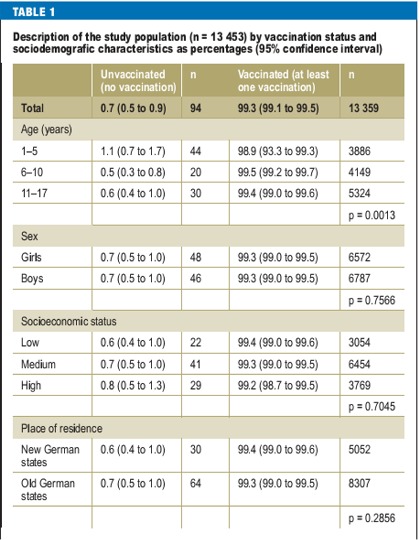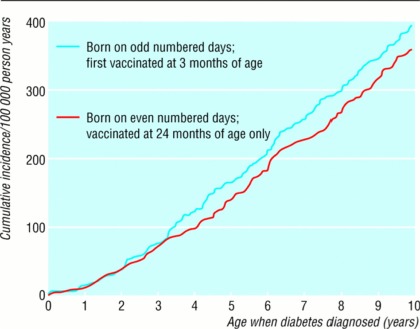This study stated a conclusion absolving vaccinations of causing harm to children. But their conclusion doesn’t match their results! Worse, though, is that close inspection shows that the study was utterly inadequate. That they showed vaccinated children have more infectious diseases, though, is rather humorous.
by Heidi Stevenson
A German study has found that unvaccinated children suffer from significantly less infectious disease than vaccinated children. Particularly humorous is that the article’s introduction contradicts the findings:
Protective vaccinations are among the most important and effective preventive measures in modern medicine. They make a substantial contribution to reducing the probability of contracting many infectious diseases as well as their severity. The immediate goal of a vaccination is to protect the vaccinated person from a disease. Achieving high rates of
vaccinated persons additionally results in the so called herd immunity.
The study found:
- Vaccinated children aged 1-5 had 27% more infectious disease than unvaccinated children.
- Vaccinated children aged 11-17 had 16% more infectious disease than unvaccinated children.
The conclusion, though, doesn’t even mention this! Instead, it states:
The prevalence of allergic diseases and non-specific infections in children and adolescents was not found to depend on vaccination status.
Of course, the researchers’ conclusion had little to do with the findings, but it’s what you must expect from a study led one researcher who was lead researcher for a major study funded by Sanofi Pasteur and GlaxoSmithKline, and another who’s employed by the Robert Koch Institute. What’s remarkable is that the study was published.
The Study
 The Robert Koch Institute, Germany’s agency for vaccine policy and its vaccination promoter, produced The German Health Interview and Examination Survey for Children and Adolescents (KiGGS). It was an interview and examination study that ran from May 2003 to May 2006, set up “to collect representative data on the health status of children and adolescents aged up to 17 years.” 17,641 children aged newborn to 17 years were selected randomly from 167 German locations. Parents were asked to participate and 66.7% did.
The Robert Koch Institute, Germany’s agency for vaccine policy and its vaccination promoter, produced The German Health Interview and Examination Survey for Children and Adolescents (KiGGS). It was an interview and examination study that ran from May 2003 to May 2006, set up “to collect representative data on the health status of children and adolescents aged up to 17 years.” 17,641 children aged newborn to 17 years were selected randomly from 167 German locations. Parents were asked to participate and 66.7% did.
Children who had received no vaccines were classified as unvaccinated, and those who’d received even one vaccination were classed as vaccinated. Only 0.7% of the children were unvaccinated, making that group quite small. They included 48 girls and 46 boys, for a total of 94 unvaccinated children.
Four Vaccination-Related Diseases
The study found that children who had received no vaccinations were significantly more likely to come down with pertussis, measles, mumps, or rubella than those they determined were “sufficiently vaccinated” against those diseases. Notice that this is a different comparison than made in all other cases, where all those classified as vaccinated were compared against those who were unvaccinated. Instead, they picked subsets of the vaccinated children for making comparisons about these diseases.
Infections Without Associated Vaccines
 When the number of infections was calculated, the story changed dramatically, as can be readily seen in the graph to the left. The infections considered included:
When the number of infections was calculated, the story changed dramatically, as can be readily seen in the graph to the left. The infections considered included:
- Cold/flu-like infection.
- Tonsillitis, herpesvirus infection. bronchitis (not when asthma was present).
- Gastrointestinal infection.
- Cystitis and/or urethritis.
- Purulent conjunctivitis (bacterial conjunctivitis).
- Croup (in children up to age 11).
Notice that unvaccinated children aged 1-5 and 11-17 were significantly less likely to suffer from any infection than vaccinated children, while the unvaccinated aged 6-10 were only slightly more likely to to suffer from an infectious disease than the vaccinated—and the p-value for that age group is exceptionally high, indicating that the age 6-10 results could easily have been reached by pure chance.
One must wonder what the results might have been if only those children who’d been fully vaccinated had been compared with unvaccinated children—as they did when they produced their results for four vaccination-related diseases. I suspect that they’d have found a significantly greater distinction between vaccinated and unvaccinated children than they did. That they did a different sort of calculation here than they did for vaccination-related diseases makes me wonder if they actually did run the numbers, but didn’t like the results.
Allergic Rhinoconjunctivitis, Atopic Eczema, & Bronchial Asthma
 The results for allergic conjunctivitis, eczema, and bronchial asthma were quite mixed, as is apparent in the graph to the shown above. The results appear to be all over the place:
The results for allergic conjunctivitis, eczema, and bronchial asthma were quite mixed, as is apparent in the graph to the shown above. The results appear to be all over the place:
- Allergic rhinoconjunctivitis seems to be more common in unvaccinated children aged 1-5, but becomes significantly less common as they age, until it’s twice as common in ages 11-17 in vaccinated children.
- The rate of atopic eczema is nearly identical in ages 1-5, becomes more common in unvaccinated children aged 6-10, and then becomes nearly 2½ times more common in vaccinated children aged 11-17.
- No cases of bronchial asthma were reported in unvaccinated children aged 1-10. Between the ages of 11 and 17, the unvaccinated had a slightly larger percentage of cases. However, the number is so small—just 2—that the comparison is fairly meaningless.
Analysis: Study Found Wanting
It’s good to see these results, but most interesting that they’ve been utterly ignored by the press and the agencies responsible for our vaccination policies. Considering the fact that the study is steeped in Big Pharma funds, the most amazing thing is that it was published. I can only imagine that there must have been some pre-arranged agreement that forced its publication.
It’s too bad, though, that the authors were allowed to get away with a conclusion that absolutely does not reflect the findings:
- Unvaccinated children clearly suffered fewer infectious diseases than vaccinated children.
- The trends in allergic rhinoconjunctivitis and atopic eczema as children get older clearly favors the unvaccinated. Only bronchial asthma might show a different trend, but that result is, as explained, questionable.
In terms of the selected vaccination-related diseases, the authors showed only numbers of cases. That, though, tells us little. It isn’t, after all, a serious matter getting these diseases in most cases. What would have been worthwhile noting is how many children suffered harm or death from them. Interestingly, the study is quiet on that.
They got only a two-thirds response from parents, but they don’t adjust for that. Could that have skewed their results. I would think so, since parents who don’t vaccinate their children tend to be suspicious of medicine and might fear taking part in such a trial.
The study did not lump all infectious diseases together, including both vaccination-related ones and non-vaccine-related conditions. That might have told a more interesting story.
They further failed to consider that only four of the vaccination-related diseases were considered, which means that each one could have been gotten by a child only once. So, from birth to age 17, they could have gotten ill only four times from those conditions, and two of those four diseases, mumps and rubella, are exceptionally mild. On top of that, they didn’t simply take note of all infectious diseases the children might have had, but only some of them. Pneumonia wasn’t considered. Are they suggesting that not a single child had pneumonia? What about encephalitis?
In terms of serious autoimmune disorders, which are the greatest concern nowadays, the study is entirely silent.
There is no investigation into the epidemic of autoimmune and neurological disorders. What about diabetes? Arthritis? Autism? Obesity? Cancer? These are all becoming more and more common in our children. Yet, the study didn’t even look at any of them.
Their claim that the study set out ”to collect representative data on the health status of children and adolescents” is demonstrably false, since the most common and worst diseases that today’s children are subject to were not even addressed.
The lack of morbidity and mortality information, the lack of any reference to autoimmune or neurological disorders, and the limitation to mostly mild infectious diseases and only four vaccination-related ones, are salient points.
If the authors had truly been interested in verifying whether vaccinated children’s health is improved orharmed, they surely would have focused on the modern plague of autoimmune and neurological disorders and accounted for all incidents of infectious diseases. It’s telling that they didn’t. It even suggests that they didn’t dare, that they had a good idea that, even though this study required some spinning, it would have been far worse, possibly unspinnable, if they’d produced an honest study.
In spite of themselves, the authors and their funders have provided information that supports the hypothesis that vaccines harm children’s health. What might have been found if they’d done an honest study investigating all aspects of health, not just a few select ones?
Any parent who presumes that agencies like the ones that produced this study actually care whether vaccines are beneficial or harmful need to think again. If they did, they’d do a genuine study comparing a large number of unvaccinated children with vaccinated ones, and they’d investigate all aspects of health, not just a few carefully selected ones.
But we can take heart in noting that, even when they tried to produce a study giving the false impression of vaccine safety, they bungled it!
Source:
- Vaccination Status and Health in Children and Adolescents, Deutsches Ärzteblatt International; Roma Schmitz, Christina Poethko-Müller, Sabine Reiter, Martin Schlaud; DOI: 10.3238/arztebl.2011.0099
Tagged big pharma, compare vaccinated and unvaccinated, conventional medicine, modern medicine, science, vaccinated children suffer, vaccinated vs unvaccinated, vaccinated vs unvaccinated children, vaccination autoimmune disorders, vaccination measles, vaccination mumps, vaccination neurological disorders, vaccination pertussis, vaccination rubella, vaccination study, vaccine autoimmune, vaccine neurological, vaccine safety







 The graph to the left is from the BMJ report. It’s of only the two cohorts that received the HiB vaccine, but the distinction between them is clear. Children given more doses of the vaccine and given them earlier are significantly more likely to come down with type 1 diabetes.
The graph to the left is from the BMJ report. It’s of only the two cohorts that received the HiB vaccine, but the distinction between them is clear. Children given more doses of the vaccine and given them earlier are significantly more likely to come down with type 1 diabetes.